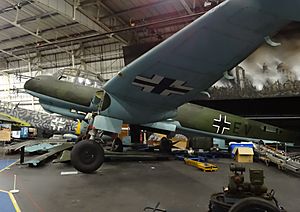Herbert Schmid facts for kids
Herbert Schmid (born April 1, 1914 – died 1975) was a German pilot during World War II. In May 1943, he made a daring flight, defecting to north-east Scotland. He flew a special German nightfighter plane that had advanced radar. This event was very important because it allowed British scientists to study the radar and learn how to block it, which helped the Allies in the war.
Contents
Early Life and Family
Herbert Schmid was born in Saxony-Anhalt, a region in Germany. His father held an important job, working as a secretary for Gustav Stresemann, who was a German Chancellor and Foreign Minister.
Pilot Career in the Luftwaffe
Schmid became a pilot in the Luftwaffe, which was Germany's air force. He served with a special unit called Nachtjagdgeschwader 3 (NJG 3), which focused on night fighting.
The Defection to Scotland in May 1943

On May 9, 1943, when Herbert Schmid was 29 years old, he flew his Junkers Ju 88 R-1 plane (number 360043) to an RAF air base near Aberdeen, Scotland. This plane was very special because it had Germany's most advanced radar system for night fighters.
He started his flight from Aalborg in Denmark at 3:03 PM. He flew to Norway to refuel his plane at 4:03 PM. After refueling, he took off again at 4:50 PM for a mission over the Skagerrak, which is a sea area between Norway and Denmark. At 5:10 PM, a fake message was sent to the German nightfighter headquarters in Denmark. The message said that Schmid's plane had an engine fire. To make it look real, the plane dropped down close to the sea and released three life rafts.
How the Plane Was Intercepted
Two Spitfire planes from 165 Squadron were sent to find Schmid's Ju 88. They met the Ju 88 at 6:05 PM, west of Aberdeen. Schmid's plane lowered its flaps and landing gear and fired red flares, which are signals. The Ju 88 landed safely at Aberdeen at 6:20 PM. One German crew member did not cooperate after landing and had to be firmly escorted.
After landing, Schmid was held as a prisoner of war. He and his crew were kept in the Officer's Mess for about a week.
Testing the Captured Aircraft
Capturing this advanced German plane was a huge win for the Allies. It meant that British scientists could now study the German nightfighter radar system. This helped them find ways to detect German nightfighters much earlier.
The captured plane, now called PJ876, was flown many times for tests. It would fly behind a Vickers Wellington plane that dropped strips of tin foil called window. These tests showed that the "window" technique, which was used to jam or confuse radar, actually worked very well.
Earlier, in December 1942, a Wellington plane had tried to find this German radar system. But that plane was shot down. Schmid's captured Ju 88 finally gave the Allies the chance to study the radar system they had been looking for.
The Aircraft's Journey
Within five days of its capture, the Ju 88 was given the new designation PJ876. It was later tested at RAF Collyweston in Northamptonshire. Much later, in November 1978, the aircraft was moved to the RAF Museum in London when the museum first opened. It is now at the Royal Air Force Museum Cosford.
Images for kids


